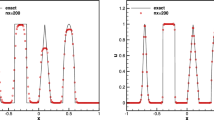Abstract
In this paper, a moving mesh discontinuous Galerkin (DG) method is developed to solve the nonlinear conservation laws. In the mesh adaptation part, two issues have received much attention. One is about the construction of the monitor function which is used to guide the mesh redistribution. In this study, a heuristic posteriori error estimator is used in constructing the monitor function. The second issue is concerned with the solution interpolation which is used to interpolates the numerical solution from the old mesh to the updated mesh. This is done by using a scheme that mimics the DG method for linear conservation laws. Appropriate limiters are used on seriously distorted meshes generated by the moving mesh approach to suppress the numerical oscillations. Numerical results are provided to show the efficiency of the proposed moving mesh DG method.
Similar content being viewed by others
References
Azarenok B.N. (2002). Variational barrier method of adaptive grid generation in hyperbolic problems of gas dynamics. SIAM J. Numer. Anal. 40, 651–682
Beckett G., Mackenzie J.A., Robertson M.L., Sloan D.M. (2001). On the numerical solutions of one-dimensional PDEs using adaptive methods based on equidistribution. J. Comput. Phys. 167, 372–392
Bey K.S., Oden J.T. (1996). hp-version discontinuous Galerkin methods for hyperbolic conservation laws. Comput. Methods Appl. Mech. Engrg. 133, 259–286
Cao W.M., Huang W.-Z., Russell R.D. (1999). An r-adaptive finite element method based upon moving mesh PDEs. J. Comput. Phys. 149, 221–244
Cao W.M., Huang W.-Z., Russell R.D. (1999). A study of monitor functions for two dimensional adaptive mesh generation. SIAM J. Sci. Comput. 20, 1978–1994
Cao W.M., Huang W.-Z., Russell R.D. (2001). An error indicator monitor function for an r-adaptive finite-element method. J. Comput. Phys. 170, 871–892
Cockburn B. (1998). An introduction to the discontinuous Galerkin method for convection-dominated problems. In: Cockburn B., Johnson C., Shu C.-W., Tadmor E. (eds). Advanced Numerical Approximation of Nonlinear Hyperbolic Equations. Springer, Berlin New York
Cockburn B., Karniadakis G.E., Shu C.W. ed. (2000). Discontinuous Galerkin Methods: Theory, Computation and Applications. Springer, Berlin
Cockburn B., Li F., Shu C.W. (2004). Locally divergence-free discontinuous Galerkin methods for the Maxwell equations. J. Comput. Phys. 197, 588–610
Cockburn B., Shu C.W. (1998). The Runge–Kutta discontinuous Galerkin finite element method for conservation laws V: Multidimensional systems. J. Comput. Phys. 141, 199–224
Cockburn B., Shu C.W. (2001). Runge–Kutta discontinuous Galerkin methods for convection-dominated problems. J. Sci. Comput. 16, 173–261
Di Y., Li R., Tang T., Zhang P.W. (2005). Moving mesh finite element methods for the incompressible Navier–Stokes equations. SIAM J. Sci. Comput. 26, 1036–1056
Dvinsky A.S. (1991). Adaptive grid generation from harmonic maps on Riemannian manifolds. J. Comput. Phys. 95, 450–476
Li R., Liu W.-B., Ma H.-P., Tang T. (2002). Adaptive finite element approximation for distributed elliptic optimal control problems. SIAM J. Control Optim. 41, 1321–1349
Li R., Tang T., Zhang P.-W. (2001). Moving mesh methods in multiple dimensions based on harmonic maps. J. Comput. Phys. 170, 562–588
Li R., Tang T., Zhang P.-W. (2002). A moving mesh finite element algorithm for singular problems in two and three space dimensions. J. Comput. Phys. 177, 365–393
Lu T., Zhang P.-W., Cai W. (2004). Discontinuous Galerkin methods for dispersive and lossy Maxwell’s equations and PML boundary conditions. To appear in J. Comput. Phys.
Tang H.Z., Tang T. (2003). Adaptive mesh methods for one- and two-dimensional hyperbolic conservation laws. SIAM J. Numer. Anal. 41, 487–515
Tang H.Z., Tang T., Zhang P.-W. (2003). An adaptive mesh redistribution method for nonlinear Hamilton-Jacobi equations in two- and three dimensions. J. Comput. Phys. 188, 543–572
Tang, T. (2005). Moving mesh methods for computational fluid dynamics. In Shi, Z.-C., Chen, Z., Tang, T. and Yu, D. (eds.), Recent Advances in Adaptive Computations (Providence, USA) Contemporary Mathematics, American Mathematical Society.
Woodward P., Colella P. (1984). The numerical simulation of two-dimensional fluid flow with strong shocks. J. Comput. Phys. 54, 115–173
Zegeling P.A. (2005). On resistive MHD models with adaptive moving meshes.To appear in J. Sci. Comput. 24, 263–284
Author information
Authors and Affiliations
Corresponding author
Rights and permissions
About this article
Cite this article
Li, R., Tang, T. Moving Mesh Discontinuous Galerkin Method for Hyperbolic Conservation Laws. J Sci Comput 27, 347–363 (2006). https://doi.org/10.1007/s10915-005-9045-9
Received:
Accepted:
Published:
Issue Date:
DOI: https://doi.org/10.1007/s10915-005-9045-9




